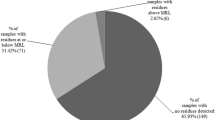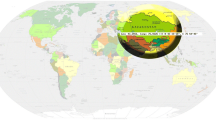Abstract
Assessment of levels of pesticide residues in vegetables was carried out in some villages in the Western Usambara and Uluguru Mountains of Tanzania where varieties of vegetables are grown. Tomatoes and cabbages were the most popular enterprise grown all year round and therefore were selected as the model crops for this study. Analysis of the cleaned sample extracts on a gas chromatography with electron capture detector (GC-ECD) and confirmation on the Gas chromatography–mass spectrometry (GC-MS) revealed dominance of organochlorine pesticides. Organophosphorous pesticides (parathion and marathion) were only detected in some samples, however, in most cases with higher concentrations compared to organochlorine pesticides. Levels of pesticide residues detected in vegetables were up to: parathion 5.07 μg/Kg, marathion 3.73 μg/Kg, α-endosulfan 0.32 μg/Kg, β-endosulfan 0.53 μg/Kg, dieldrin 1.36 μg/Kg, γ-HCH 0.25 μg/Kg, α-HCH 0.09 μg/Kg, and p, p′-DDT 0.64 μg/Kg. These results clearly show that vegetables are contaminated with different pesticide residues. However, the total levels of pesticide residues in both tomatoes and cabbages are lower than their respective codex alimentarius maximum residue levels (MRLs). This means that the vegetables produced in the area are suitable for human consumption.














Similar content being viewed by others
References
AGENDA and Pesticide Action Network, UK (2006) Pesticide and poverty: a case study on trade and utilization of pesticides in Tanzania and implication to stockpiling, Final report.
Anon, A (1992) Scientific agriculture prevents mass starvation. The Herxter. J. of the Agvet Division, Hoechst, Aust. Inc.
Cuadros Rodrı́guez, L., Hernández Torres, M. E., Almansa López, E., Egea González, F. J., Arrebola Liébanas, F. J., & Martı́nez Vidal, J. L. (2002). Assessment of uncertainty in pesticide multiresidue analytical methods: main sources and estimation. Analytica Chimica Acta, 454(2), 297–314. https://doi.org/10.1016/S0003-2670(01)01546-X.
Ehardt, C. L., Jones, T. P., & Butynski, T. M. (2005). Protective status, ecology and strategies for improving conservation of Cercocebus sanjei in the Udzungwa Mountains, Tanzania. International Journal of Primatology, 26(3), 557–583. https://doi.org/10.1007/s10764-005-4366-y.
FAO, & WHO. (2005). Joint FAO/WHO food standards programme: codex committee on pesticide residues, draft and proposed maximum residue limits in food and feed, Netherlands, Final report.
FAO, & WHO. (2007). Joint FAO/WHO food standards programme: codex committee on pesticide residues, draft and proposed maximum residue limits in food and feed, China, Final report.
FAO, & WHO. (2003). Joint FAO/WHO food standards programme: codex committee on pesticide residues, draft and proposed maximum residue limits in food and feed, Netherlands, Final report.
Journalists Environmental Association of Tanzania (JET) (1997) Banned DDT on sale in Tanzania. Pesticides News, 35.
Kent, J. (1991). Pesticides in agriculture. Bathurst: Charles Sturt University.
Kishimba, M. A., Henry, L., Mwevura, H., Mmochi, A. J., Mihale, M., & Hellar, H. (2004). The status of pesticide pollution in Tanzania. Talanta, 64(1), 48–53. https://doi.org/10.1016/j.talanta.2003.11.047.
Mpagalile, J., Mkangwa, C., & Lwakabare, P. (2008). Consultancy report on stakeholders mapping for post harvest innovation platform for Ulanga, Kilombero, Kilosa and Mvomero District-Morogoro Tanzania, Final report.
Mtashobya, L. A., & Nyambo, B. (2014). Levels of pesticide residues in the Eastern Arc Mountains part of Tanzania. International Journal of AgriScience, 4(10), 452–462.
Myers, N., Mittermeier, R. A., Mittermeier, C. G., da Fonseca, G. A. B., & Kent, J. (2000). Biodiversity hotspots for conservation priorities. Nature, 403(6772), 853–858 http://www.nature.com/nature/journal/v403/n6772/suppinfo/403853a0_S1.html.
Ngowi, A. V. F., Mbise, T. J., Ijani, A. S. M., London, L., & Ajayi, O. C. (2007). Smallholder vegetable farmers in Northern Tanzania: pesticides use practices, perceptions, cost and health effects. Crop Protection, 26(11), 1617–1624. https://doi.org/10.1016/j.cropro.2007.01.008.
Nyambo, B., Maundu, J., & Macharia, I. (2006). Promotion of integrated pest management for vegetable production in the Eastern Arc Mountains & East African Coastal Forest Mosaic Biodiversity Hotspots. Nairobi: ICIPE.
Ragnar, Ø., Axel, B., Evelyne, L., & Temu, A. (2002). Poverty-reducing effects of agricultural development in Tanzania (final report): Noragric Agricultural University of Norway, Norway.
Pinstrup-Andersen, P. (2000). Future world food situation and the role of plant diseases. Canadian Journal of Plant Pathology, 22(4), 321–331.
Acknowledgements
The author appreciates the financial support from Mkwawa University College of Education and The Eastern Arc Mountains Conservation Endowment Fund. The author sincerely acknowledges the potential contribution of the late Prof. Michael A. Kishimba and advice and assistance from Messrs. John Mahugija Marco, Lutufyo Mwamtobe, and Geoffrey Malisa. The author also extends his gratitude to Prof. B.T. Kiremire for accepting the request to confirm samples on the Gas Chromatography Mass Spectrometer (GC-MS) in the Chemistry Department at the University of Makerere. The author finally thanks Mr. Bitainensha Christopher for his technical support and Ms. Hasifa Nakayima and Mr. Edward Mubiru for their kind support in Uganda.
Author information
Authors and Affiliations
Corresponding author
Ethics declarations
Conflict of interest
The author declares no competing financial interest.
Electronic supplementary material
ESM 1
(DOCX 1252 kb)
Rights and permissions
About this article
Cite this article
Mtashobya, L.A. Assessment of pesticide residues in vegetables from the Western Usambara and Uruguru Mountains in Tanzania. Environ Monit Assess 189, 519 (2017). https://doi.org/10.1007/s10661-017-6226-6
Received:
Accepted:
Published:
DOI: https://doi.org/10.1007/s10661-017-6226-6




